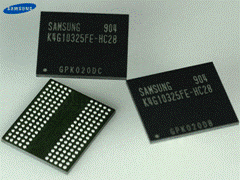
Samsung Electronics ha reso noto di aver avviato la produzione in volumi dei chip di RAM G-DDR5 - "la più veloce e performante memoria del pianeta, ideale per il gaming su tutte le piattaforme" in accordo a Mueez Deen di Samsung - facendo ricorso ad un innovativo processo tecnologico a 55nm.
Le nuove G-DDR5 possono vantare data transfer massimo pari a 7.0Gbps ed una banda massima di 28GB/s, che è pari a più del doppio di quella offerta dalle G-DDR4 (12.8GB/s). A seguito della adozione del processo di fabbricazione più raffinato, il consumo di potenza risulta ridotto di circa il 20% (le nuove G-DDR5 operano a 1.35 V mentre le G-DDR4 a 1.8).
Samsung ha previsto una rapida diffusione delle G-DDR5, che raggiungeranno il 20% del mercato della memoria RAM entro fine anno, secondo le stime del produttore.

[Immagine ad alta risoluzione]

Samsung Electronics Co., Ltd., the world leader in advanced memory technology and the leading producer of high-end graphics memory, announced today that it has begun mass producing GDDR5 graphics memory using 50-nanometer class process technology.
"Our early 2009 introduction of GDDR5 chips will help us to meet the growing demand for higher performance graphics memory in PCs, graphic cards and game consoles," said Mueez Deen, director, mobile and graphics memory, Samsung Semiconductor, Inc. "Because GDDR5 is the fastest and highest performing memory in the world, we're able to improve the gaming experience with it across all platforms," he added.
Designed to support a maximum data transfer speed of 7.0Gbps, Samsung's GDDR5 will render more life-like (3D) imaging with a maximum 28GB/s bandwidth, which is more than twice that of the previous fastest graphics memory bandwidth of 12.8GB/s for GDDR4. The ultra-fast processing speed is equivalent to transferring nineteen 1.5GB DVD resolution movies in one second. The high image processing speed of the GDDR5 also supports the latest data formats (Blu-ray and full HD).
Unlike GDDR4, which processes data and images using the strobe-and-clock technique, the processing speed of the GDDR5 is much faster because it operates with a free-running clock that does not require the data read/write function to be synchronized to the operations of the clock. By adopting 50nm class technology, Samsung expects production efficiency to rise 100 percent over 60nm class technology. In addition, Samsung's GDDR5 operates at 1.35 volts (V), which represents a 20 percent reduction in power consumption compared to the 1.8V at which GDDR4 devices operate.
Now available in a 32Megabit (Mb) x32 configuration and also configurable as a 64Mb x16 device, Samsung expects GDDR5 to account for over 20 percent of the total graphic memory market in 2009. The company also said it plans to expand the 50-nm process technology throughout its graphics memory line-up this year.
Source: Samsung Press Release
Links



